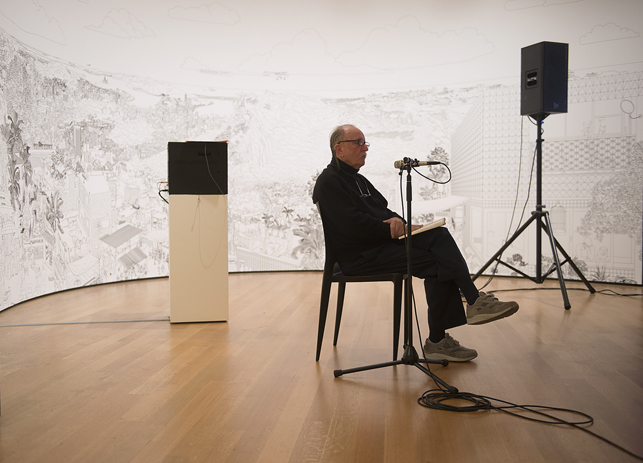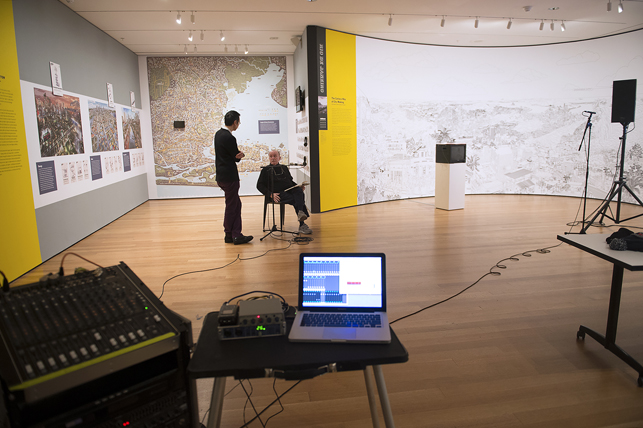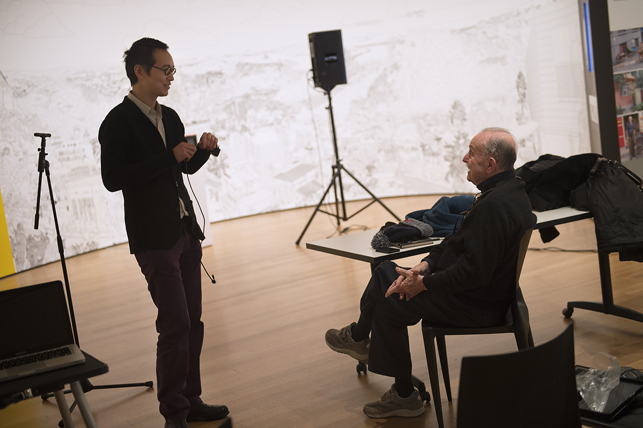In 1969 American composer Alvin Lucier first performed his landmark work I Am Sitting in a Room, conceived for voice and electromagnetic tape. Lucier read a text into a microphone. Attempting to smooth out his stutter, he began with the lines, “I am sitting in a room, the same one you are in now. I am recording the sound of my speaking voice.” As described in the text, his voice was recorded, then played back into the room. This process was repeated, and with each iteration Lucier’s recorded speech grew muddled, sounding distant, and specific sonic frequencies started to dominate the recorded sound. These tones that began to overwhelm the text and abstract the sonic landscape are the room’s resonant frequencies and are entirely specific to the architectural particularity of a given space. As these frequencies grew, reinforced with each playback, the result was an erasure of the human performer and the dominance of an environmental music.

Alvin Lucier recording I Am Sitting in a Room at The Museum of Modern Art, New York, on Saturday, December 20, 2014. Assisted by James Fei. Photo: Amanda Lucier. © 2015 Amanda Lucier
A close friend and colleague of John Cage, Pauline Oliveros, and David Tudor, among others, Lucier occupies a formative place in the history of experimental music. Within this lineage, I Am Sitting in a Room is influential for its treatment of space as a component of sonic production. Indeed, the conceptual crux of the work is a radical reversal of the logic of musical composition: rather than using traditionally musical means to create sounds, Lucier used a technological process to reveal naturally occurring acoustic phenomena. The work’s context within MoMA’s collection highlights its synchronicity with themes across a variety of artistic disciplines in the 1960s and 1970s including the creation of art environments as well as structuralist and minimalist impulses. Building upon exhibitions such as Soundings: A Contemporary Score, MoMA’s recent acquisition of both I Am Sitting in a Room and Lucier’s Music for Pure Waves, Bass Drums and Acoustic Pendulums (1980) continues the Museum’s dedication to representing the history of sound art within a broader context of 20th–century artistic practice.
Coinciding with MoMA’s acquisition of more sound art and performance, such as works by Lawrence Abu Hamdan, Stephen Vitiello, and Kevin Beasley, I Am Sitting in a Room provides a view into the myriad of challenging questions raised by acquisitions of ephemeral artworks. How does a museum acquire an experimental music performance? What does the museum actually receive? And if the museum doesn’t acquire a physical object, what is the value of adding this work to the collection? (Similar questions have been discussed in previous blog posts, such as this one and this one, to name just a few.) In consultation with Lucier himself, the curatorial team decided that the acquisition would include both the ability for others to perform the work in the future and an archival recording of the composer performing the piece himself at MoMA. (Lucier is no stranger to MoMA; he performed the work Chambers as a part of The Machine and Nature, an audio-visual concert on January 15 and 16, 1969.) He will provide the Museum with a set of instructions guiding the re-performance of the work in the future, a practice other artists such as Kevin Beasley have used in other MoMA acquisitions.

Alvin Lucier recording I Am Sitting in a Room at The Museum of Modern Art, New York, on Saturday, December 20, 2014. Assisted by James Fei. Photo: Amanda Lucier. © 2015 Amanda Lucier

Alvin Lucier recording I Am Sitting in a Room at The Museum of Modern Art, New York, on Saturday, December 20, 2014. Assisted by James Fei. Photo: Amanda Lucier. © 2015 Amanda Lucier
This past December, a small group gathered at the Museum after hours on a Saturday evening to produce the recording. Having transitioned from an analog set-up to digital, Lucier worked with trusted audio engineer James Fei, substituting a laptop for two tape recorders. We sat in near silence, and after a number of sound checks, the performance began. Lucier spoke deliberately, this time with hardly a stutter. As the recorded sound of his speech grew faint and the frequencies more distinct, we witnessed sound as physical fact. No longer just an auditory phenomenon, this was a physical, material, and spatial experience, implicating the institutional architecture of the room in the radical nature of the piece. Eventually the recorded sound transformed into a complete abstraction of the original, specific to the very walls around us. As the performer’s individual subjectivity gradually disappeared from the recording and sounds produced by the architecture of the space dominated the sonic experience, I felt the relationship between the auditory experience and its material production, descending into a phenomenology of sound.
This recording, forever linking I Am Sitting in a Room to the walls of the Museum is hardly definitive. There are a number of recordings of the piece including the original and a version from 1980 released on Lovely Music, Ltd. Each recording has its own temporality—it’s own relationship to a time and place. Each one is an artifact, an articulation of Lucier’s presence at a given point in our continuum. But the presence of the work in MoMA’s collection has an entirely different temporality. As Stuart Comer, Chief Curator in the Department of Media and Performance Art, phrased it, the ability to perform the piece “allows it to exist in a constant state of imminence.” A collection of sound art is the endless possibility of bringing the work into fruition, a commitment to the work’s future status as having not just a past but also a present.
[Editor's note, August 10, 2020: At a Sonic Arts Union concert at the Solomon R. Guggenheim Museumthe following year, I Am Sitting in a Room premiered alongside Mary Lucier's Polaroid Image Series, which used a similar conceptual process in visual form. Mary Lucier used a Polaroid copier to reproduce the original images, resulting in slight errors and visual noise that eventually transformed the images from their original form. These images from the ROOM slide series were projected simultaneously with the original 23-minute audio work, an example of collaboration that explored similar interests across different mediums.]

